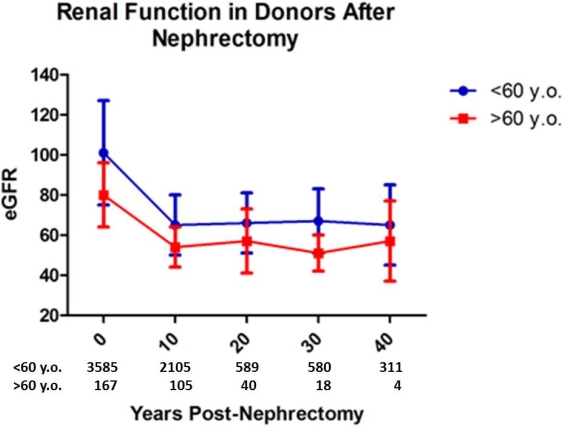Outcomes of Donor Nephrectomy in the Elderly.
1Surgery, Univ. of Minnesota, Minneapolis, MN
2Biostatistics and Bioinformatics Core, Masonic Cancer Center, Minneapolis, MN
3Biostatistics, Univ. of Minnesota, Minneapolis, MN.
Meeting: 2016 American Transplant Congress
Abstract number: A124
Keywords: Donation, Elderly patients, Kidney, Nephrectomy
Session Information
Session Name: Poster Session A: Kidney Donor Outcomes
Session Type: Poster Session
Date: Saturday, June 11, 2016
Session Time: 5:30pm-7:30pm
 Presentation Time: 5:30pm-7:30pm
Presentation Time: 5:30pm-7:30pm
Location: Halls C&D
PURPOSE: The critical organ shortage has increased demand for marginal donor kidneys. Although previously a contraindication to live kidney donation, advanced age donors (>60 y.o.) have become more common, raising concerns about their long-term health.
METHODOLOGY: All donor and recipient records of DN performed between 1975 and 2014 were reviewed. Donor and recipient demographics, intraoperative parameters, complications, and short- and long-term outcomes were compared between contemporaneous donors >60 y.o. and <60 y.o. in a matched-control design.
RESULTS: Between 1975 and 2014, we performed 3,752 DN: 2,275 open (ODN), 1,477 laparoscopic DN (LDN). Among donors, 167 (4.5%) were >60 y.o. On univariate analysis, >60 y.o. donors were more likely to have had prior abdominal surgery (p<0.001) and have documented hypertension (p<0.001); and less likely to smoke (p<0.001). Baseline estimated glomerular filtration rate (eGFR) was different between >60 y.o. (80+16) and <60 y.o. donors (101+26; p<0.001). Intraoperative and post-operative complications were similar among the 2 groups, with the exception of <30 day ileus, which was more frequent among >60 y.o. donors (p=0.02). Post-operative Length of stay (LOS) was longer for >60 y.o. donors (p=0.005). On multivariate analysis, <30 day ileus (HR 1.50, 95%CI 1.28-1.77) and LOS (HR 0.4, 95%CI 0.2-0.7) were greater for >60 y.o. donors. After >20 years post-DN, systolic blood pressure was significantly higher among >60 y.o. donors (142+21 vs 125+16; p<0.001) and HTN was diagnosed earlier post-DN (9 vs 14 years; p<0.001). Estimated glomerular filtration rate (eGFR) was significantly lower for >60 y.o. donors (Figure 1) but slope of eGFR or rates of end-stage renal disease (ESRD) did not seem to be significantly different >20 years after DN (p=0.26).
CONCLUSION: Kidney donation among carefully-selected >60 y.o. donors poses minimal perioperative risks and a no added risk of ESRD.

CITATION INFORMATION: Serrano O, Bangdiwala A, Yadav K, Adamusiak A, Vock D, Payne W, Dunn T, Chinnakotla S, Finger E, Pruett T, Matas A, Kandaswamy R. Outcomes of Donor Nephrectomy in the Elderly. Am J Transplant. 2016;16 (suppl 3).
To cite this abstract in AMA style:
Serrano O, Bangdiwala A, Yadav K, Adamusiak A, Vock D, Payne W, Dunn T, Chinnakotla S, Finger E, Pruett T, Matas A, Kandaswamy R. Outcomes of Donor Nephrectomy in the Elderly. [abstract]. Am J Transplant. 2016; 16 (suppl 3). https://atcmeetingabstracts.com/abstract/outcomes-of-donor-nephrectomy-in-the-elderly/. Accessed December 12, 2025.« Back to 2016 American Transplant Congress
